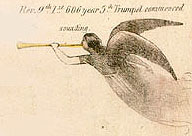 Detail from a Millerite Poster |
from Narrative of A. Gordon Pym (1838) from Walden (1854) |
Thoreau's Walden is neither a "pretext" to Uncle Tom's Cabin (it was published two years later) nor "Christian" (Thoreau refers to the Bible in his first chapter, for example, as "an old book"), but it is striking to note how much his description of spring relies on the tropes and images of the Christian apocalypse, and when he glosses the heaving of the earth in the Deep Cut, his analysis is as intricate, even neurotic, as Miller's parsing of scriptural and temporal dates to compute the end of the world. As a sign of the times, Transcendentalism shared with the Millerites and the author of Uncle Tom's Cabin a hunger for apocalyptic change.
The other two texts are more skeptical. In his one completed novel, Poe's apocalyptic imagination locates the end of the world as a point in space rather than time, but the "signs" and "wonders" Pym encounters point toward, if they don't ever arrive at, the prospect of a new heaven and a new earth. In his tale, Hawthorne's emblematic imagination uses "Father Miller's prophecies" to take a fresh look at the old earth.
 Detail from a Millerite Poster |
from Narrative of A. Gordon Pym (1838) from Walden (1854) |
